diagram MITSUBISHI 380 2005 Repair Manual
[x] Cancel search | Manufacturer: MITSUBISHI, Model Year: 2005, Model line: 380, Model: MITSUBISHI 380 2005Pages: 1500, PDF Size: 47.87 MB
Page 308 of 1500
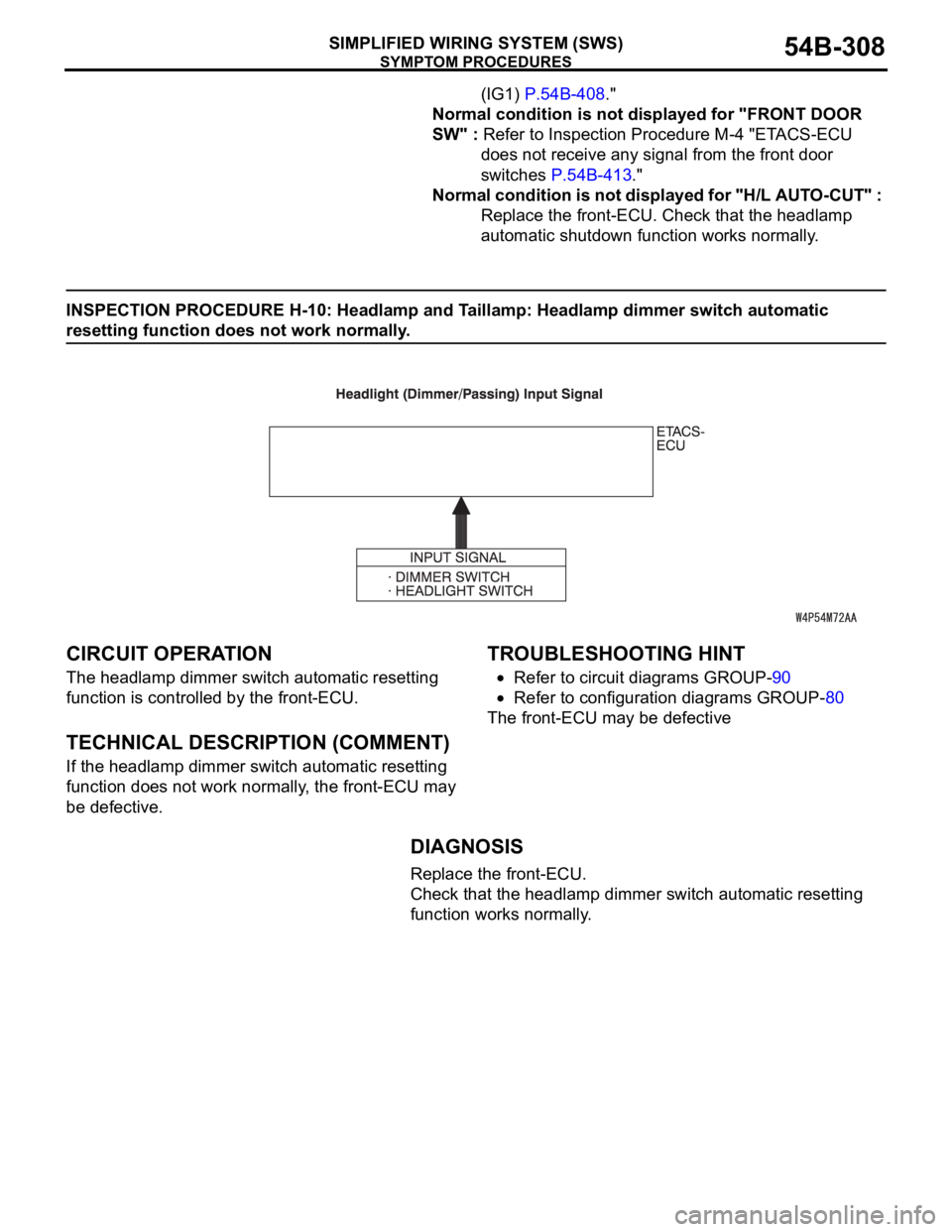
SYMPTOM PROCEDURES
SIMPLIFIED WIRING SYSTEM (SWS)54B-308
(IG1) P.54B-408."
Normal condition is not displayed for "FRONT DOOR
SW" : Refer to Inspection Procedure M-4 "ETACS-ECU
does not receive any signal from the front door
switches P.54B-413."
Normal condition is not displayed for "H/L AUTO-CUT" :
Replace the front-ECU. Check that the headlamp
automatic shutdown function works normally.
INSPECTION PROCEDURE H-10: Headlamp and Taillamp: Headlamp dimmer switch automatic
resetting function does not work normally.
.
CIRCUIT OPERATION
The headlamp dimmer switch automatic resetting
function is controlled by the front-ECU.
.
TECHNICAL DESCRIPTION (COMMENT)
If the headlamp dimmer switch automatic resetting
function does not work normally, the front-ECU may
be defective.
.
TROUBLESHOOTING HINT
Refer to circuit diagrams GROUP-90
Refer to configuration diagrams GROUP-80
The front-ECU may be defective
DIAGNOSIS
Replace the front-ECU.
Check that the headlamp dimmer switch automatic resetting
function works normally.
Page 309 of 1500
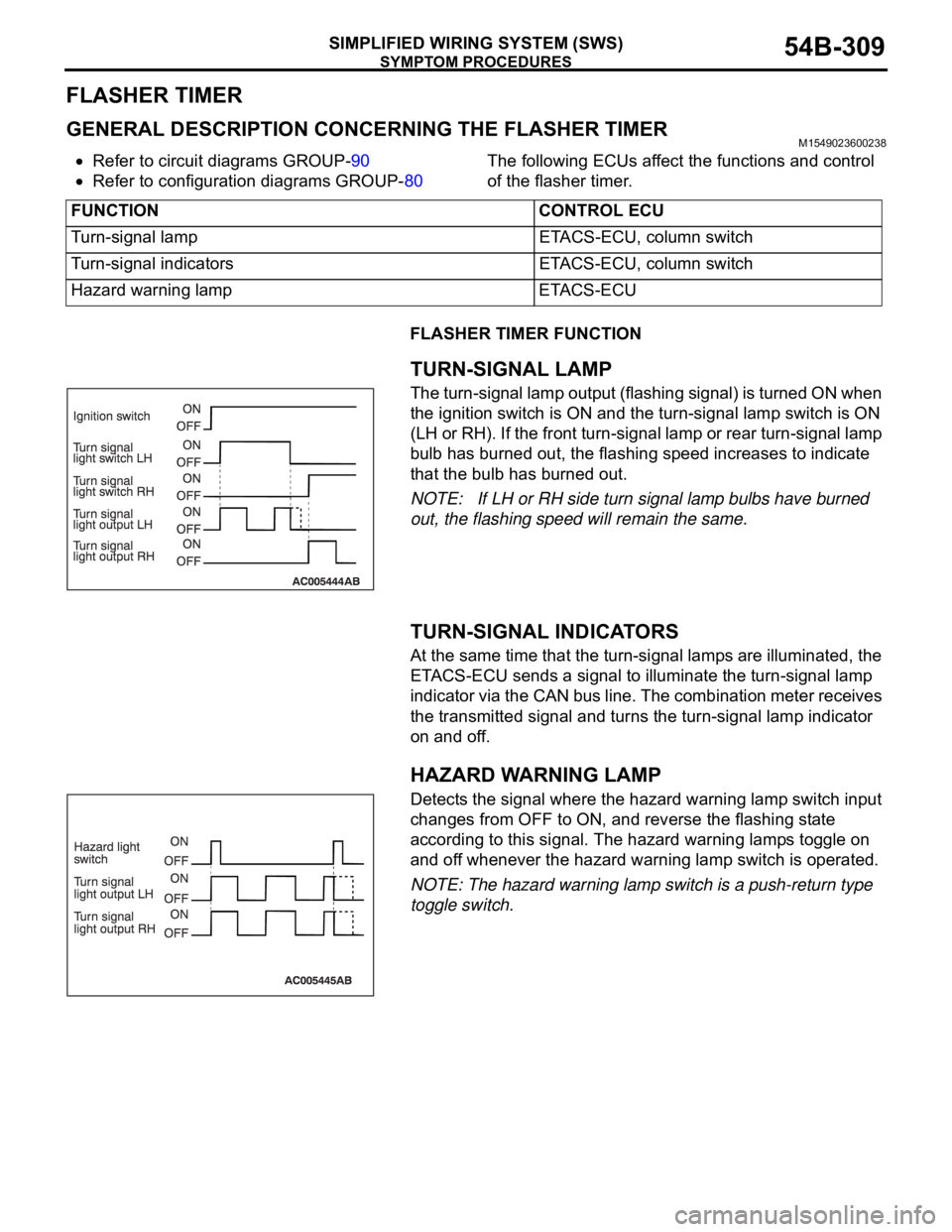
SYMPTOM PROCEDURES
SIMPLIFIED WIRING SYSTEM (SWS)54B-309
FLASHER TIMER
GENERAL DESCRIPTION CONCERNING THE FLASHER TIMERM1549023600238
Refer to circuit diagrams GROUP-90
Refer to configuration diagrams GROUP-80The following ECUs affect the functions and control
of the flasher timer.
FLASHER TIMER FUNCTION
.
TURN-SIGNAL LAMP
The turn-signal lamp output (flashing signal) is turned ON when
the ignition switch is ON and the turn-signal lamp switch is ON
(LH or RH). If the front turn-signal lamp or rear turn-signal lamp
bulb has burned out, the flashing speed increases to indicate
that the bulb has burned out.
NOTE: If LH or RH side turn signal lamp bulbs have burned
out, the flashing speed will remain the same.
.
TURN-SIGNAL INDICATORS
At the same time that the turn-signal lamps are illuminated, the
ETACS-ECU sends a signal to illuminate the turn-signal lamp
indicator via the CAN bus line. The combination meter receives
the transmitted signal and turns the turn-signal lamp indicator
on and off.
.
HAZARD WARNING LAMP
Detects the signal where the hazard warning lamp switch input
changes from OFF to ON, and reverse the flashing state
according to this signal. The hazard warning lamps toggle on
and off whenever the hazard warning lamp switch is operated.
NOTE: The hazard warning lamp switch is a push-return type
toggle switch. FUNCTION CONTROL ECU
Turn-signal lamp ETACS-ECU, column switch
Turn-signal indicators ETACS-ECU, column switch
Hazard warning lamp ETACS-ECU
Page 310 of 1500
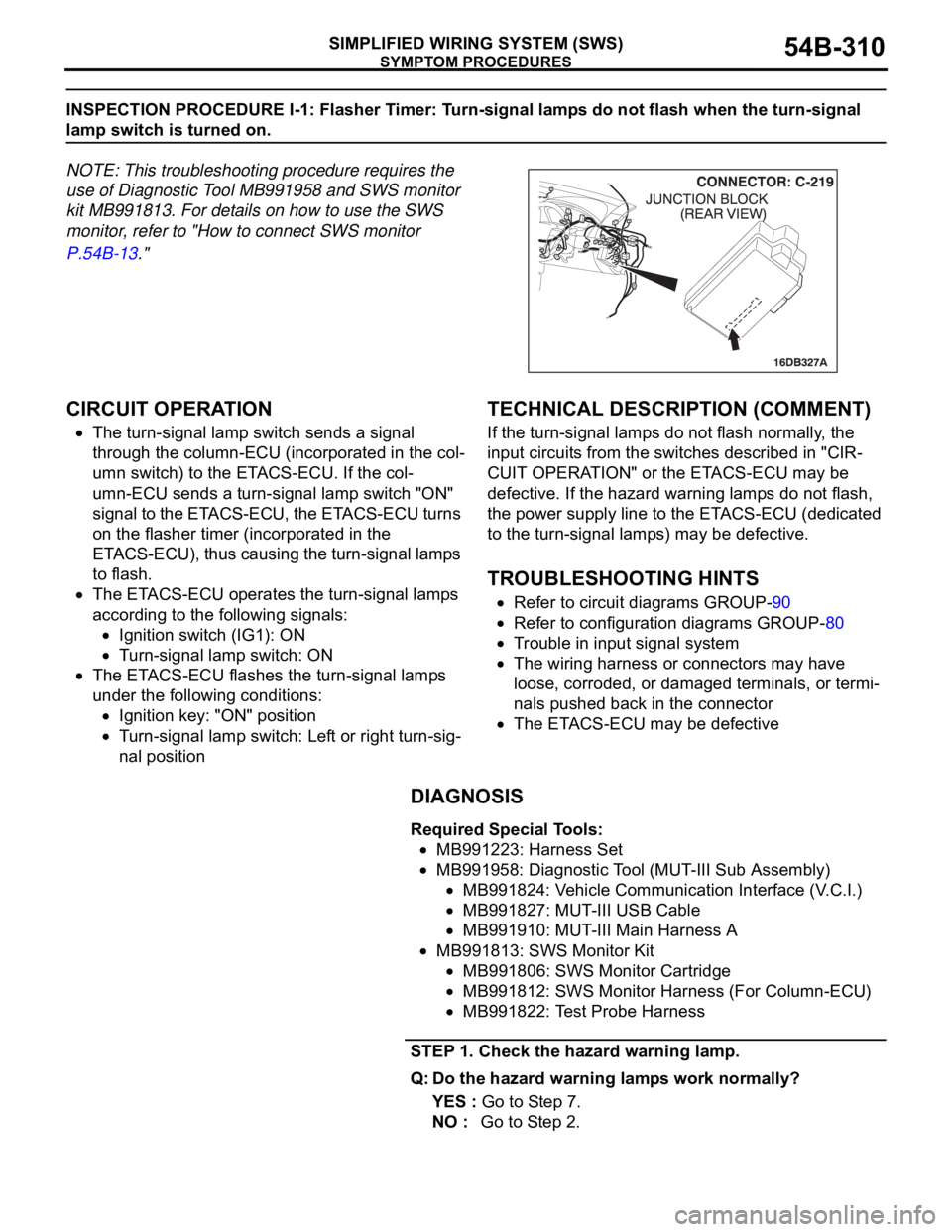
SYMPTOM PROCEDURES
SIMPLIFIED WIRING SYSTEM (SWS)54B-310
INSPECTION PROCEDURE I-1: Flasher Timer: Turn-signal lamps do not flash when the turn-signal
lamp switch is turned on.
NOTE: This troubleshooting procedure requires the
use of Diagnostic Tool MB991958 and SWS monitor
kit MB991813. For details on how to use the SWS
monitor, refer to "How to connect SWS monitor
P.54B-13."
.
CIRCUIT OPERATION
The turn-signal lamp switch sends a signal
through the column-ECU (incorporated in the col-
umn switch) to the ETACS-ECU. If the col-
umn-ECU sends a turn-signal lamp switch "ON"
signal to the ETACS-ECU, the ETACS-ECU turns
on the flasher timer (incorporated in the
ETACS-ECU), thus causing the turn-signal lamps
to flash.
The ETACS-ECU operates the turn-signal lamps
according to the following signals:
Ignition switch (IG1): ON
Turn-signal lamp switch: ON
The ETACS-ECU flashes the turn-signal lamps
under the following conditions:
Ignition key: "ON" position
Turn-signal lamp switch: Left or right turn-sig-
nal position
.
TECHNICAL DESCRIPTION (COMMENT)
If the turn-signal lamps do not flash normally, the
input circuits from the switches described in "CIR-
CUIT OPERATION" or the ETACS-ECU may be
defective. If the hazard warning lamps do not flash,
the power supply line to the ETACS-ECU (dedicated
to the turn-signal lamps) may be defective.
.
TROUBLESHOOTING HINTS
Refer to circuit diagrams GROUP-90
Refer to configuration diagrams GROUP-80
Trouble in input signal system
The wiring harness or connectors may have
loose, corroded, or damaged terminals, or termi-
nals pushed back in the connector
The ETACS-ECU may be defective
DIAGNOSIS
Required Special Tools:
MB991223: Harness Set
MB991958: Diagnostic Tool (MUT-III Sub Assembly)
MB991824: Vehicle Communication Interface (V.C.I.)
MB991827: MUT-III USB Cable
MB991910: MUT-III Main Harness A
MB991813: SWS Monitor Kit
MB991806: SWS Monitor Cartridge
MB991812: SWS Monitor Harness (For Column-ECU)
MB991822: Test Probe Harness
STEP 1. Check the hazard warning lamp.
Q: Do the hazard warning lamps work normally?
YES : Go to Step 7.
NO : Go to Step 2.
Page 314 of 1500
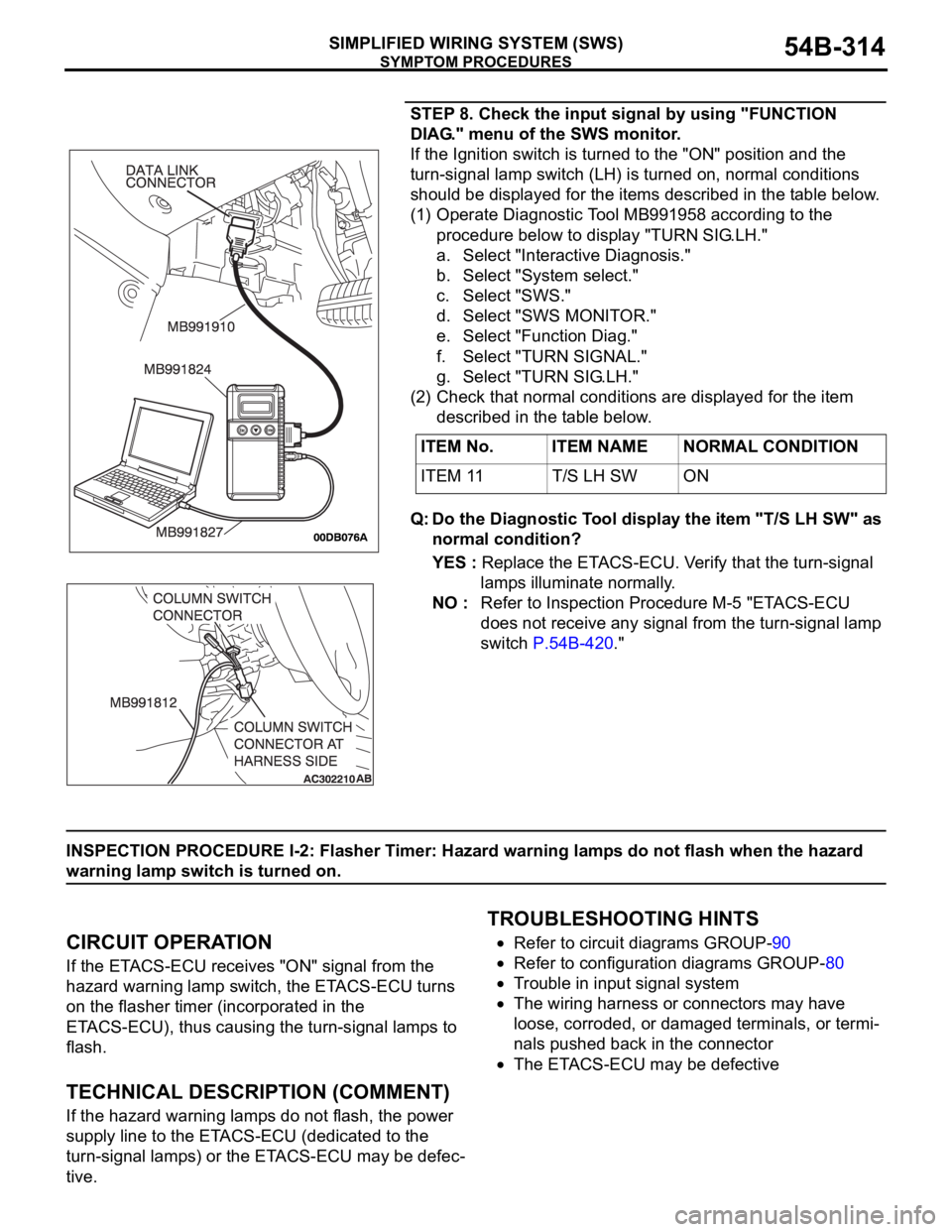
SYMPTOM PROCEDURES
SIMPLIFIED WIRING SYSTEM (SWS)54B-314
STEP 8. Check the input signal by using "FUNCTION
DIAG." menu of the SWS monitor.
If the Ignition switch is turned to the "ON" position and the
turn-signal lamp switch (LH) is turned on, normal conditions
should be displayed for the items described in the table below.
(1) Operate Diagnostic Tool MB991958 according to the
procedure below to display "TURN SIG.LH."
a. Select "Interactive Diagnosis."
b. Select "System select."
c. Select "SWS."
d. Select "SWS MONITOR."
e. Select "Function Diag."
f. Select "TURN SIGNAL."
g. Select "TURN SIG.LH."
(2) Check that normal conditions are displayed for the item
described in the table below.
Q: Do the Diagnostic Tool display the item "T/S LH SW" as
normal condition?
YES : Replace the ETACS-ECU. Verify that the turn-signal
lamps illuminate normally.
NO : Refer to Inspection Procedure M-5 "ETACS-ECU
does not receive any signal from the turn-signal lamp
switch P.54B-420."
INSPECTION PROCEDURE I-2: Flasher Timer: Hazard warning lamps do not flash when the hazard
warning lamp switch is turned on.
.
CIRCUIT OPERATION
If the ETACS-ECU receives "ON" signal from the
hazard warning lamp switch, the ETACS-ECU turns
on the flasher timer (incorporated in the
ETACS-ECU), thus causing the turn-signal lamps to
flash.
.
TECHNICAL DESCRIPTION (COMMENT)
If the hazard warning lamps do not flash, the power
supply line to the ETACS-ECU (dedicated to the
turn-signal lamps) or the ETACS-ECU may be defec-
tive.
.
TROUBLESHOOTING HINTS
Refer to circuit diagrams GROUP-90
Refer to configuration diagrams GROUP-80
Trouble in input signal system
The wiring harness or connectors may have
loose, corroded, or damaged terminals, or termi-
nals pushed back in the connector
The ETACS-ECU may be defective ITEM No. ITEM NAME NORMAL CONDITION
ITEM 11 T/S LH SW ON
Page 316 of 1500

SYMPTOM PROCEDURES
SIMPLIFIED WIRING SYSTEM (SWS)54B-316
INSPECTION PROCEDURE I-3: Flasher Timer: One of the turn-signal lamps does not illuminate.
.
TECHNICAL DESCRIPTION (COMMENT)
If the right or left turn-signal lamp does not illuminate,
their bulb may be defective.
.
TROUBLESHOOTING HINTS
Refer to circuit diagrams GROUP-90
Refer to configuration diagrams GROUP-80
The turn-signal lamp bulb may be defective
The wiring harness or connectors may have
loose, corroded, or damaged terminals, or termi-
nals pushed back in the connector
.
Page 335 of 1500
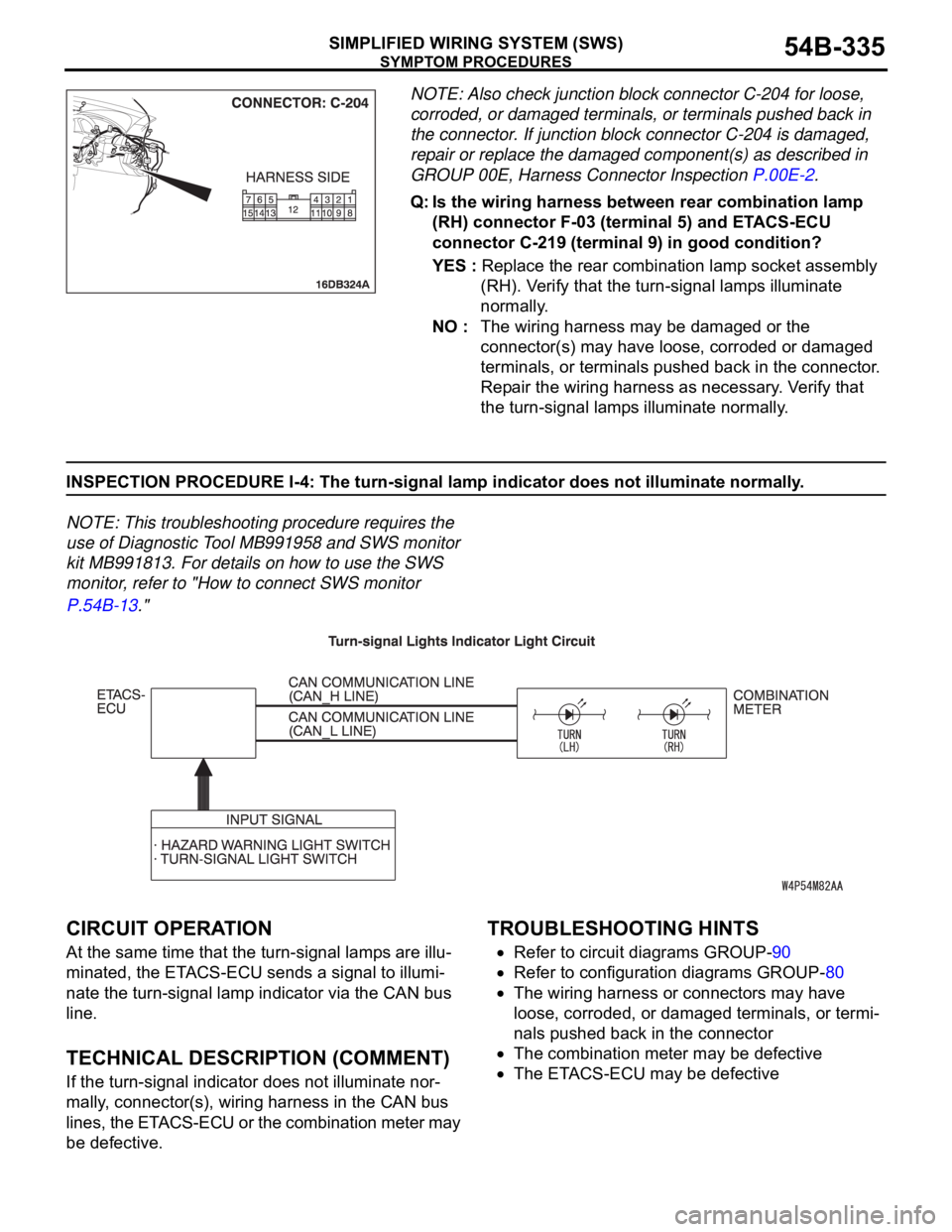
SYMPTOM PROCEDURES
SIMPLIFIED WIRING SYSTEM (SWS)54B-335
NOTE: Also check junction block connector C-204 for loose,
corroded, or damaged terminals, or terminals pushed back in
the connector. If junction block connector C-204 is damaged,
repair or replace the damaged component(s) as described in
GROUP 00E, Harness Connector Inspection P.00E-2.
Q: Is the wiring harness between rear combination lamp
(RH) connector F-03 (terminal 5) and ETACS-ECU
connector C-219 (terminal 9) in good condition?
YES : Replace the rear combination lamp socket assembly
(RH). Verify that the turn-signal lamps illuminate
normally.
NO : The wiring harness may be damaged or the
connector(s) may have loose, corroded or damaged
terminals, or terminals pushed back in the connector.
Repair the wiring harness as necessary. Verify that
the turn-signal lamps illuminate normally.
INSPECTION PROCEDURE I-4: The turn-signal lamp indicator does not illuminate normally.
NOTE: This troubleshooting procedure requires the
use of Diagnostic Tool MB991958 and SWS monitor
kit MB991813. For details on how to use the SWS
monitor, refer to "How to connect SWS monitor
P.54B-13."
.
CIRCUIT OPERATION
At the same time that the turn-signal lamps are illu-
minated, the ETACS-ECU sends a signal to illumi-
nate the turn-signal lamp indicator via the CAN bus
line.
.
TECHNICAL DESCRIPTION (COMMENT)
If the turn-signal indicator does not illuminate nor-
mally, connector(s), wiring harness in the CAN bus
lines, the ETACS-ECU or the combination meter may
be defective.
.
TROUBLESHOOTING HINTS
Refer to circuit diagrams GROUP-90
Refer to configuration diagrams GROUP-80
The wiring harness or connectors may have
loose, corroded, or damaged terminals, or termi-
nals pushed back in the connector
The combination meter may be defective
The ETACS-ECU may be defective
.
Page 339 of 1500

SYMPTOM PROCEDURES
SIMPLIFIED WIRING SYSTEM (SWS)54B-339
FOG LAMP
GENERAL DESCRIPTION CONCERNING THE FOG LAMPSM1549021400216
Refer to circuit diagrams GROUP-90
Refer to configuration diagrams GROUP-80The following ECUs affect the functions and control
of the fog lamps.
Fog lamp
The fog lamps will illuminate only when the fog lamp
switch is operated while the low-beam headlamps
are on.
The fog lamps will be switched off when any of the
following conditions is met. The fog lamps will also
be switched off automatically by headlamp automatic
shutoff function.
When the high-beam headlamps are switched
on, the fog lamps will be switched off. If the
low-beam headlamps are switched on again, the
fog lamps will illuminate again.
When the headlamp switch is turned off or the tail
lamps and headlamps are off, the fog lamps will
be switched off. If the low-beam headlamps are
switched on again, the fog lamps will not illumi-
nate again.
Fog lamp indicator
At the same time that the fog lamps are illuminated, the
ETACS-ECU sends a signal to illuminate the fog lamp indicator
via the CAN bus line. The combination meter receives the
transmitted signal and turns the fog lamp indicator on and off. FUNCTION CONTROL ECU
Fog lamp ETACS-ECU, front-ECU, column switch
Fog lamp indicator ETACS-ECU, column switch
Page 340 of 1500
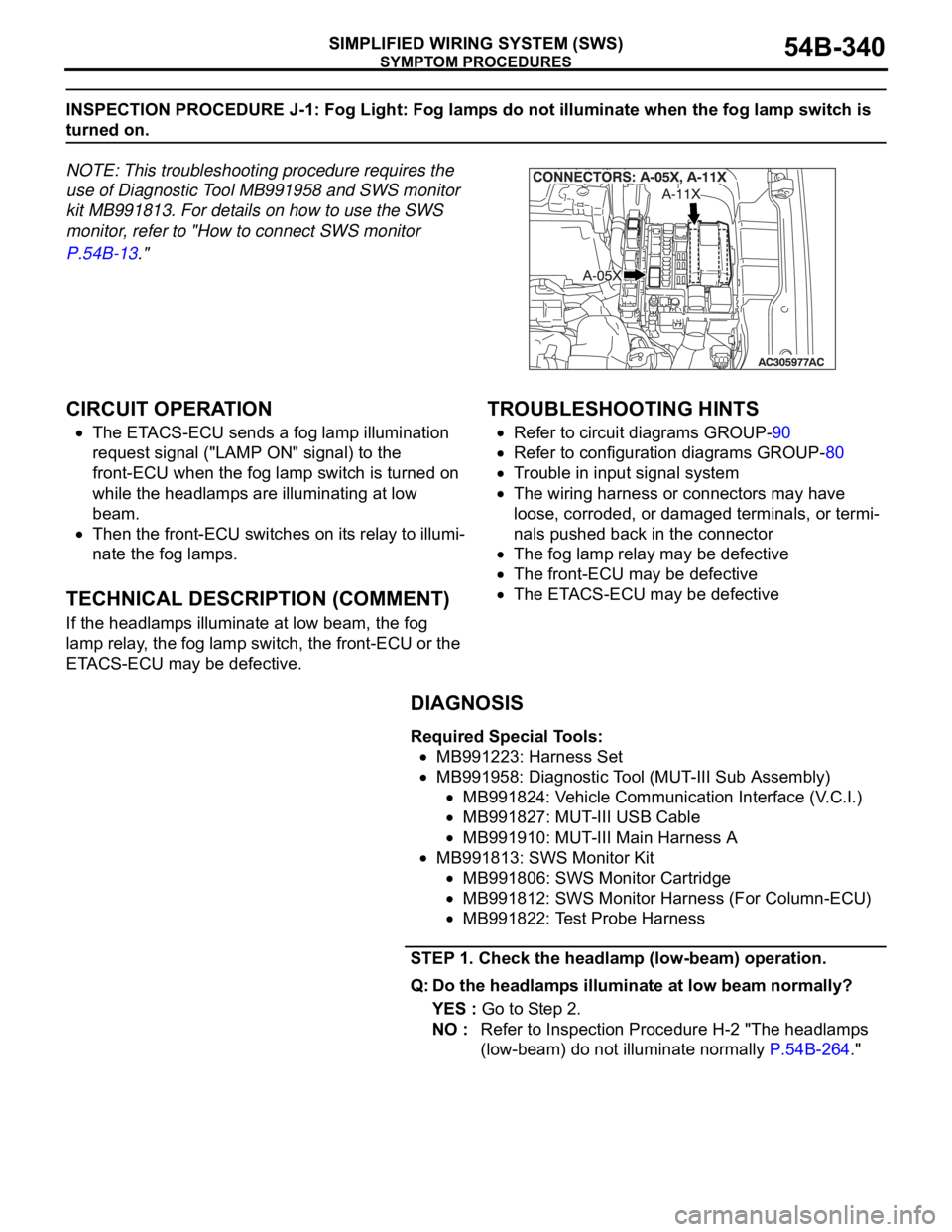
SYMPTOM PROCEDURES
SIMPLIFIED WIRING SYSTEM (SWS)54B-340
INSPECTION PROCEDURE J-1: Fog Light: Fog lamps do not illuminate when the fog lamp switch is
turned on.
NOTE: This troubleshooting procedure requires the
use of Diagnostic Tool MB991958 and SWS monitor
kit MB991813. For details on how to use the SWS
monitor, refer to "How to connect SWS monitor
P.54B-13."
.
CIRCUIT OPERATION
The ETACS-ECU sends a fog lamp illumination
request signal ("LAMP ON" signal) to the
front-ECU when the fog lamp switch is turned on
while the headlamps are illuminating at low
beam.
Then the front-ECU switches on its relay to illumi-
nate the fog lamps.
.
TECHNICAL DESCRIPTION (COMMENT)
If the headlamps illuminate at low beam, the fog
lamp relay, the fog lamp switch, the front-ECU or the
ETACS-ECU may be defective.
.
TROUBLESHOOTING HINTS
Refer to circuit diagrams GROUP-90
Refer to configuration diagrams GROUP-80
Trouble in input signal system
The wiring harness or connectors may have
loose, corroded, or damaged terminals, or termi-
nals pushed back in the connector
The fog lamp relay may be defective
The front-ECU may be defective
The ETACS-ECU may be defective
DIAGNOSIS
Required Special Tools:
MB991223: Harness Set
MB991958: Diagnostic Tool (MUT-III Sub Assembly)
MB991824: Vehicle Communication Interface (V.C.I.)
MB991827: MUT-III USB Cable
MB991910: MUT-III Main Harness A
MB991813: SWS Monitor Kit
MB991806: SWS Monitor Cartridge
MB991812: SWS Monitor Harness (For Column-ECU)
MB991822: Test Probe Harness
STEP 1. Check the headlamp (low-beam) operation.
Q: Do the headlamps illuminate at low beam normally?
YES : Go to Step 2.
NO : Refer to Inspection Procedure H-2 "The headlamps
(low-beam) do not illuminate normally P.54B-264."
Page 345 of 1500
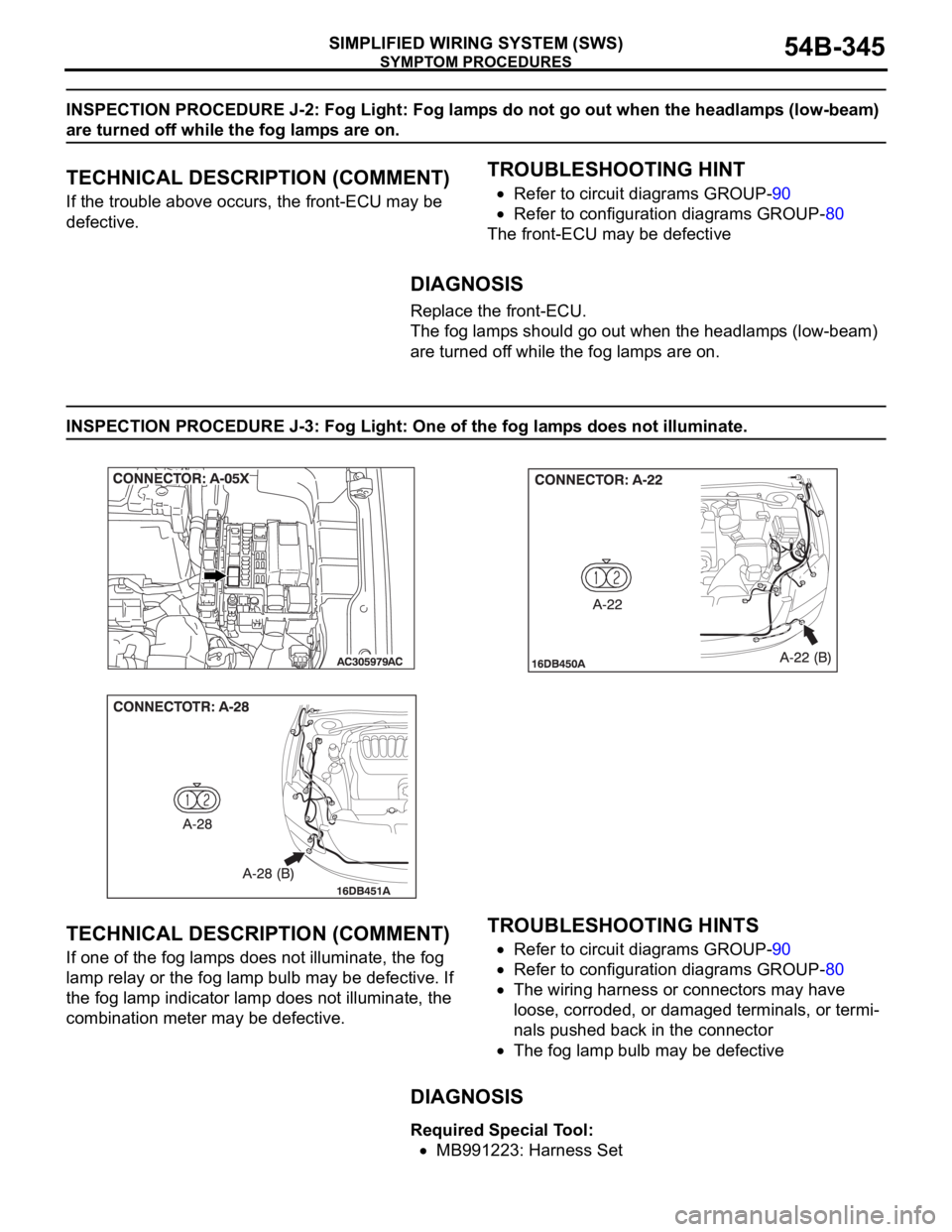
SYMPTOM PROCEDURES
SIMPLIFIED WIRING SYSTEM (SWS)54B-345
INSPECTION PROCEDURE J-2: Fog Light: Fog lamps do not go out when the headlamps (low-beam)
are turned off while the fog lamps are on.
.
TECHNICAL DESCRIPTION (COMMENT)
If the trouble above occurs, the front-ECU may be
defective.
.
TROUBLESHOOTING HINT
Refer to circuit diagrams GROUP-90
Refer to configuration diagrams GROUP-80
The front-ECU may be defective
DIAGNOSIS
Replace the front-ECU.
The fog lamps should go out when the headlamps (low-beam)
are turned off while the fog lamps are on.
INSPECTION PROCEDURE J-3: Fog Light: One of the fog lamps does not illuminate.
.
TECHNICAL DESCRIPTION (COMMENT)
If one of the fog lamps does not illuminate, the fog
lamp relay or the fog lamp bulb may be defective. If
the fog lamp indicator lamp does not illuminate, the
combination meter may be defective.
.
TROUBLESHOOTING HINTS
Refer to circuit diagrams GROUP-90
Refer to configuration diagrams GROUP-80
The wiring harness or connectors may have
loose, corroded, or damaged terminals, or termi-
nals pushed back in the connector
The fog lamp bulb may be defective
.
DIAGNOSIS
Required Special Tool:
MB991223: Harness Set
Page 351 of 1500

SYMPTOM PROCEDURES
SIMPLIFIED WIRING SYSTEM (SWS)54B-351
CIRCUIT OPERATION
At the same time that the fog lamps are illuminated,
the ETACS-ECU sends a signal to illuminate the fog
lamp indicator via the CAN bus line.
.
TECHNICAL DESCRIPTION (COMMENT)
If the fog lamp indicator does not illuminate normally,
connector(s), wiring harness in the CAN bus lines,
the ETACS-ECU or the combination meter may be
defective.
.
TROUBLESHOOTING HINTS
Refer to circuit diagrams GROUP-90
Refer to configuration diagrams GROUP-80
Trouble in input signal system
The wiring harness or connectors may have
loose, corroded, or damaged terminals, or termi-
nals pushed back in the connector
The combination meter may be defective
The ETACS-ECU may be defective
.